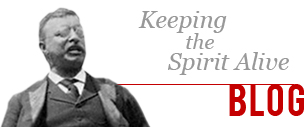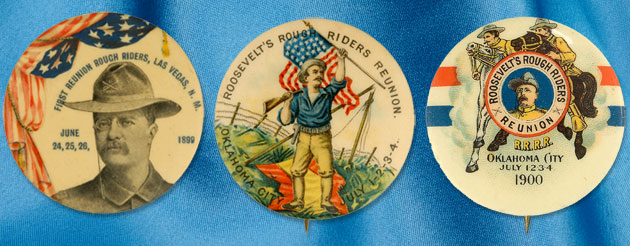The Rough Riders—those who survived Spanish bullets and disease—were quarantined at the end of the Spanish-American War at Camp Wykoff [Wyckoff] on Montauk, Long Island, N.Y. Those who had remained in Florida due to lack of transport to Cuba arrived by train August 10, 1898, and those who fought in Cuba returned via the ship Miami on August 14. Before mustering out September 15, they organized the Rough Riders Association, with Alexander O. Brodie elected as president and plans made for the first reunion to coincide with the anniversary of the Battle of Las Guasimas.
As many members of the 1st United States Volunteer Cavalry came from the southwest, Las Vegas, N.M. was chosen as the reunion site. Come June 24-26, 1900, about 600 officers and men reunited, out of the 1200 on the September 1898 muster out roll. Roosevelt, now governor of New York, journeyed by train to join them, with boisterous, large crowds greeting him at each stop along the way. He stayed a mere 36 hours in Las Vegas.
At least two artifacts were made for the event. One, a ribbon badge given to attending Rough Riders, featured a figural brass “USV” cavalry hat as the bar pin. The other was a give-away from an advertiser located on Las Vegas’ Plaza where much of the reunion activities took place. This celluloid button, made by Whitehead & Hoag of Newark, N.J., holds their back paper with the additional text: “Rough Rider’s Souvenir: Compliments Of Ilfeld’s The Plaza.” This was a dry goods firm founded by Charles Ilfeld.
The second reunion took place in Oklahoma City, July 1-4, 1900. TR missed the first day’s memorial service, which had a crowd estimated at 10,000. On July 3, the New York Times reported his Oklahoma City arrival thusly: “Five Thousand People Give Him A Wild Western Greeting / Makes Much Applauded Speech The Keynote Of Which Is Expansion.” About 200 Rough Riders attended. Roosevelt was present only for the procession and his own speech.
As vice-president writing in advance of the reunion in 1901, TR commented to his friend and Rough Rider officer, William Henry Harrison Llewellyn: “I want you to help me to see to it that these annual reunions are stopped, and that we do not have another reunion until say 1905.” Roosevelt feared the reputation of the regiment would be damaged by the host cities’ unfettered self-promotion and their use of the regiment, as Roosevelt put it, “as the central feature of a public spectacle.
“Accordingly, there were additional sporadic reunions, but as far as this writer knows, badges and other souvenirs after 1900 are extremely rare, if they exist.








Keith Simon
August 12, 2013 at 1:20 PMRough Rider reunions ran right thru 1968. They tried to force the locals to tamp down the self-promotion efforts. Of interest. NOT all the Rough Riders attended. FEW Rough Riders who got left behind attended the Annual Reunions past 1900. Also, some Rough Riders outright refused to attend. For example, the 1st Rough Rider to fire a the 1st shot in battle, Trooper Tom Isbell, a half-breed Cherokee in the L troop, under the squad of Sgt Hamilton Fish, and who was wounded no less than seven times, refused to attend Rough Rider Conventions. He felt that the Rough Riders got far too much press coverage during and after the Spanish-American War and that there was not enough credit due to the 17,000 other soldiers who made up the V Corps in Cuba.